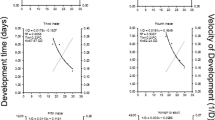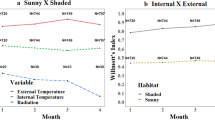Abstract
IN view of the economic importance of the glasshouse red spider mite, it is desirable that the effect of environment on its rate of development be accurately determined in order that the intervals between applications of acaricide can be estimated effectively. The only available experimental figures are those of Van Marle1 and of Linke2, and these are either based on a few scattered observations or cover an outdoor temperature-range too low to be applicable to glasshouse conditions. As our results suggest a more rapid development at high temperatures than has hitherto been assumed, we are publishing some preliminary figures in Table 1.
This is a preview of subscription content, access via your institution
Access options
Subscribe to this journal
Receive 51 print issues and online access
$199.00 per year
only $3.90 per issue
Buy this article
- Purchase on Springer Link
- Instant access to full article PDF
Prices may be subject to local taxes which are calculated during checkout
Similar content being viewed by others
References
Van Marle, G. S., Spintbestrijding. proofstation, Aalsmeer, Holland (1951).
Linke, W., Höfchen. Briefe, 6 (4), 182 (1953).
Boudreaux, H. B., Ann. Ent. Soc. Amer., 49, 43 (1956).
Callan, E. McC., Nature, 160, 432 (1947).
Author information
Authors and Affiliations
Rights and permissions
About this article
Cite this article
HUSSEY, N., PARR, W. & CROCKER, C. Effect of Temperature on the Development of Tetranychus telarius L.. Nature 179, 739–740 (1957). https://doi.org/10.1038/179739a0
Issue Date:
DOI: https://doi.org/10.1038/179739a0
Comments
By submitting a comment you agree to abide by our Terms and Community Guidelines. If you find something abusive or that does not comply with our terms or guidelines please flag it as inappropriate.



